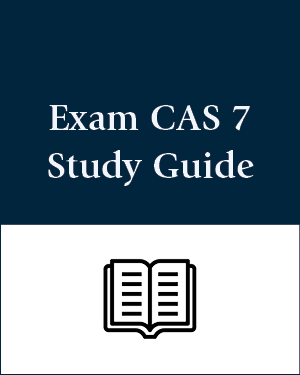
Introduction
CAS Exam 7 SyllabusIf you’re diving into the world of actuarial science, the CAS (Casualty Actuarial Society) exams are a significant milestone in your career. Among these, CAS Exam 7 is crucial for anyone focusing on reserving techniques. This exam is not just another hurdle; it’s a comprehensive assessment that tests your knowledge and skills in advanced reserving methods. So, what exactly does CAS Exam 7 entail, and how can you conquer it? Let’s break it down.
Understanding the CAS Exam 7 Syllabus Structure
First things first, understanding the structure of the exam is essential. CAS Exam 7 primarily focuses on the estimation of unpaid claims, otherwise known as reserving. The exam consists of multiple-choice questions and written-answer questions, designed to test both your theoretical knowledge and practical application skills.
Format of the Exam: The exam is typically split into two parts – multiple-choice questions to test your basic understanding and written-answer questions that delve deeper into your analytical abilities.
Duration and Passing Criteria: The exam lasts for about four hours. To pass, you need to demonstrate a strong grasp of the material, typically requiring a score that ranks in the top percentage of examinees, though the exact passing score can vary.
Main Topics Covered in CAS Exam 7 Syllabus
The syllabus for CAS Exam 7 is extensive, covering a range of topics from basic reserving techniques to more advanced methods. Here’s a closer look at what you need to master.
Detailed Breakdown of the CAS Exam 7 Syllabus
Basic Reserving Techniques
Chain Ladder Method
The Chain Ladder Method is one of the foundational techniques in reserving. It involves projecting future claims based on past claims data.
Application and Examples: You’ll often use historical loss data to predict future claims, adjusting for factors like inflation.
Advantages and Limitations: While straightforward, the Chain Ladder Method can be less accurate if there are significant changes in claim patterns.
Bornhuetter-Ferguson Method
This method combines historical claims data with expert judgment, offering a more balanced approach.
Application and Examples: Typically used when the historical data is sparse or unreliable, combining it with an a priori estimate.
Advantages and Limitations: More flexible than the Chain Ladder Method but relies heavily on the accuracy of the initial assumptions.
Cape Cod Method
A hybrid between the Chain Ladder and Bornhuetter-Ferguson methods, the Cape Cod Method adjusts the initial estimate based on actual claims experience.
Application and Examples: Useful in situations where past data trends are expected to continue.
Advantages and Limitations: Offers a compromise between data-driven and judgment-based methods but can be complex to implement.
Advanced Reserving Techniques for CAS Exam 7 Syllabus
Generalized Linear Models (GLM)
GLMs extend linear regression to accommodate various types of data distributions, providing a more robust analytical tool.
Application and Examples: Used for modeling frequency and severity of claims, accounting for different predictors.
Advantages and Limitations: Highly versatile but requires a good understanding of statistical modeling.
Bayesian Models
Bayesian methods incorporate prior knowledge into the reserving process, updating estimates as new data becomes available.
Application and Examples: Effective in incorporating expert opinion and evolving data.
Advantages and Limitations: Can provide more accurate estimates but computationally intensive.
Stochastic Reserving Models
These models incorporate random variability, offering a probabilistic approach to reserving.
Application and Examples: Useful for assessing the range of possible outcomes and associated risks.
Advantages and Limitations: Provides a comprehensive risk assessment but can be difficult to interpret.
Other Important Topics for CAS Exam 7 Syllabus
Reinsurance
Reinsurance can significantly impact reserving strategies.
Types of Reinsurance: From proportional to non-proportional reinsurance, each type affects the reserving process differently.
Impact on Reserving: Understanding how reinsurance contracts influence claim liabilities is crucial.
Financial Reporting
Accurate reserving is critical for financial reporting.
Regulatory Requirements: Compliance with regulations like GAAP and IFRS is essential.
Impact on Reserving: Ensuring that reserves meet regulatory standards while reflecting true liabilities.
Study Tips for CAS Exam 7 Syllabus
Effective Study Techniques
Time Management
Start early and plan your study schedule. Divide the syllabus into manageable sections and set clear deadlines.
Practice Problems
Work through past exam papers and sample problems. This will not only test your knowledge but also improve your exam technique.
Utilizing Study Resources for CAS Exam 7 Syllabus
Recommended Books
Several textbooks cover the syllabus comprehensively. “Loss Models: From Data to Decisions” and “Predictive Modeling Applications in Actuarial Science” are highly recommended.
Online Resources
Websites like the CAS official site, actuarial forums, and online courses can provide additional support and study materials.
Conclusion
Conquering CAS Exam 7 is no small feat, but with a thorough understanding of the syllabus and effective study techniques, you can certainly succeed. Focus on mastering both basic and advanced reserving techniques, utilize a variety of resources, and practice diligently.
FAQs
What is the best way to prepare CAS Exam 7 Syllabus?
Start early, create a detailed study plan, and use a variety of resources including textbooks, online courses, and practice exams.
How much study time is recommended forCAS Exam 7 Syllabus?
On average, candidates spend about 300-400 hours preparing for the exam, spread over several months.
Are there any specific resources that are highly recommended?
Yes, “Loss Models: From Data to Decisions” and “Predictive Modeling Applications in Actuarial Science” are excellent starting points.
What are the common challenges faced by students?
Common challenges include managing the vast syllabus, understanding complex models, and applying theoretical knowledge to practical problems.
How often is CAS Exam 7 updated?
The syllabus for CAS Exam 7 is reviewed and updated periodically to reflect the latest industry practices and regulatory changes.
